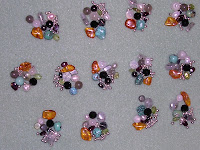
THREE STUDENTS WINDING THEIR COLOR HOROSCOPE WARPS.
I am finally back home in sunny Seattle! It was a wonderful trip. There was lots of weather including an "end of the world" type wind and rain storm. Living in Seattle has made me appreciate all kinds of weather. I was concerned that my 7 ft. tall Japanese Tree Peony would have already blossomed, but it has waited for me. I counted over a dozen buds, the most I have ever had. I can't wait to show you pictures. But I digress.
Blue Ridge Spinners and Weavers is a fun loving group. I don't think they expected quite as intense a workshop (at least the second day when everybody wound their Color Horoscope warps), but they did it! The first day was pretty relaxed. I regaled the group with an exciting slide show and a yummy show and tell. I've gotten really good at packing a ton of samples into a carry-on piece of luggage.

ALMOST ALL OF THE CLASS POSING WITH THEIR WARPS.
I don't know what happened to the other 5 students.
The main goal of the workshop is to shake up the rules of color in weaving. Each warp consists of 12 colors (a basic spectrum). These colors combine to make over 5 billion color possibilities. Since the human eye sees only about 8 million variations, I think of this exercise as the "dog whistle" of color:) I continue to be amazed and delighted by the color variations even after 28 years. I think of these
weavings as a living rainbow.
"If you were a rainbow, this is the rainbow you would be."I talk about
Color Horoscope Weaving on my website and also in
Syne Mitchell's
Weavecast Episode #9.
The downside of the workshop for me is that I don't get to see the finished weaving. I always ask students to send me pictures, but they rarely do. I have some finished pieces displayed in my web gallery
"Inspired By Bonnie". Do take a look.
The upside for the student is they don't have to drag a loom to the workshop. Since the weaving is plain weave an easily woven off, there really isn't any reason to spend workshop time in this fashion.
On the third day, we made horoscope necklaces using the same draft used to wind the warp. I will put the horoscope necklace day into the next post. I have one funny picture I want to use, but I have to get permission before I post it.
I can always tell a successful workshop because I end up learning ways to make the workshop more streamlined, which is a good thing because I am teaching it at
NEWS in July as a one-day workshop instead of a two-day workshop.
 When the end is in sight, it is always exciting!
When the end is in sight, it is always exciting! If you can't figure out what the pink strings are doing and why they are there, you'll just have to ask. I don't mind explaining if necessary.
If you can't figure out what the pink strings are doing and why they are there, you'll just have to ask. I don't mind explaining if necessary. I'll have some better pictures, but I wanted to give you an idea of the direction the blanket is taking. Although these are only 2 of 7 panels, these 2 panels make up 40% of the blanket's area.
I'll have some better pictures, but I wanted to give you an idea of the direction the blanket is taking. Although these are only 2 of 7 panels, these 2 panels make up 40% of the blanket's area.




















